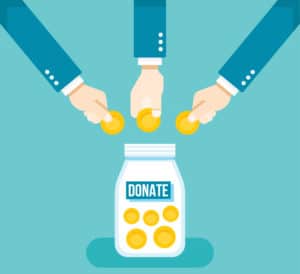3 Ways To Improve Your 2020 Fundraising Program

This post has been updated with information on COVID-19 and the U.S. presidential election.
Here we are, 2020 – hopefully ready to improve your fundraising program. Whether you’re ready to start planning before January 1 or revisiting your plan mid-year, it’s always important to focus on your fundraising efforts. More specifically, focus on how you can make this the best year yet for your nonprofit.
Here are 3 ways you can improve your fundraising program this year.
1. Be Transparent With Your Donors
This may seem like an obvious point, but it’s one that is very important. Your donors trust you to steward their money well and you must show them your followthrough. By “transparent” we mean both financial and program transparency.
Financial Transparency
Yes, you have to release an IRS form 990 every year to show how you’re allocating your funds, but your donors aren’t going to sit and read through that long document. Make sure you give your donors an easy way to digest how you’re investing their money. Create a graph, chart, infographic etc. And if it looks like you spent more in one category than expected, explain why. Your donors love your mission and giving them a peek behind the curtain creates a sense of belonging and teamwork.
Program Transparency
This is about showing impact. Sure, donors may want to know what percentage of donations you spent on your fundraising software. But they also want to know how many people you’ve helped, wells you’ve dug, animals you’ve saved, etc. If you create an annual report, that’s a great start. Pull information from your annual report to use in your fundraising materials. There are several different types of nonprofit infographics you can include on your website that will allows your donors to easily see the impact their giving is having.
January is the perfect time to start collecting this data. So let your program staff know to start keeping track of their impact, or assign a specific person to do this. Either way, make sure that you start 2020 off right.
2. Optimize Your Donor Experience

Personalization is no longer just putting “Hey %FirstName%” in your communications. It’s about knowing what your donors’ interests are, reaching out to them when it’s right, and with the right giving amount. It’s marketing 101 – reaching the right audience with the right message at the right time.
Sounds overwhelming, but it’s really not if you have the right tools. This is where segmenting your list comes in (and making sure you have a database that allows you to easily segment your donors). You can segment based on last gift amount, last gift date, a specific campaign – anything that gleans insight about your donors. You can then create fundraising messaging around each category.
Donor optimization also includes reaching donors in ways they’re most comfortable. Ask yourself the following questions to see if you are optimizing your donor experience.
- Are people giving through a mobile device? If so, think of ways how you can optimize that experience for them. In 2017, 25% of donors completed their donations on mobile devices.
- Tip: Test where you place the donate button on your webpages. See whether having a donate button at the top before scrolling through text or at the bottom after you’ve explained the offer works better for your audience. Make sure your donation pages are always optimized for any device.
- Are more donors giving online this year over last year? If so, how can you optimize your online fundraising efforts? According to the 2016 M+R Benchmark Study online giving increased 21% over the previous year with nonprofit monthly website traffic increasing 8%.
- Tip: Test having one call to action (“Donate”) versus having an additional call to action (“Learn More”) on your homepage to see which drives more donations.
- Can your donors give recurring monthly gifts?If so, how can you increase your monthly givers this year? And if not, think about how you can get a monthly giving program started. According to the same M+R Benchmark Study, online monthly giving increased 24%!
- Tip: Need some help optimizing your monthly giving program? No worries, we’ve got this helpful Monthly Giving Guide, for you.
3. Audit Your Systems

It’s really hard to optimize your donor experience and increase your transparency if you don’t have the right tools in place. A great practice at the beginning of the year is to audit the systems you’re using. Or, if you aren’t using any, now is a great time to figure out what systems will help you optimize your fundraising program.
Here are a few questions to help you with your audit:
- How much time are you spending in your current data systems vs how much time you are spending talking to donors? If you’re spending more time in your data, it’s probably time to look for a more advanced system.
- Do your systems talk to each other? For example, if someone gave to a follow-up email after an event they attended, are you able to easily track in your database how much they gave, to what specific email, and what event?
- Can you easily run reports? Whether it’s for board meetings or for day-to-day use, does your current system allow you to access your data and run a report quickly and easily?
There are many great tools out there. But you need a system that’s a good fit for your organization. Keep your priorities in mind when you’re doing your audit and choose systems that will help you grow and meet your organization’s goals for 2020.
Adapting Your Plan For COVID-19 & The U.S. Presidential Election
Even if you’ve had a solid fundraising program planned since January 1, it’s likely you didn’t consider the effect of a pandemic on your nonprofit. That’s why it’s important to revisit your fundraising plan and make changes accordingly. Consider investing more in virtual fundraising opportunities like peer-to-peer fundraising. Find ways to connect with your donors outside of in-person meetings. Look into some creative alternatives to in-person events.
Though you’ll likely have to make some changes, there are plenty of resources to help you navigate the effects of the coronavirus on fundraising. Check out our Coronavirus Resource Center for Nonprofits for a complete list of our favorite resources.
Another important factor to consider is the 2020 U.S. Presidential Election. If your nonprofit has donors from the United States, it’s important to consider how the election may affect your fundraising efforts. Read more about what the research says about how previous elections have affected nonprofits, and take steps to anticipate how it might affect you this year, too.
How The 2020 Presidential Election Could Impact Your Nonprofit
And there you have it! These are 3 fundamental ways to improve your fundraising program in 2020 – and you can start implementing them today. So, let’s get started and make 2020 the best year yet!
Schedule a live demo with Bloomerang, and we’ll show you how easy it is to create and automate reports, utilize online and offline fundraising tools, quickly integrate and access all your data, and ultimately create more time to engage your donors.